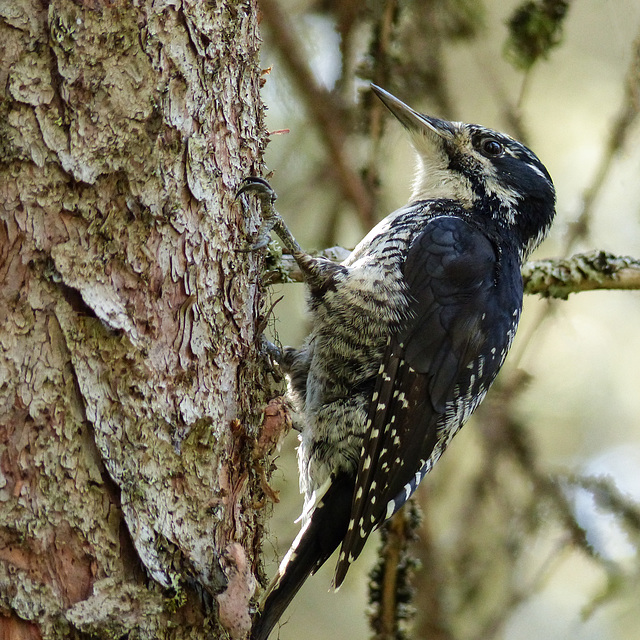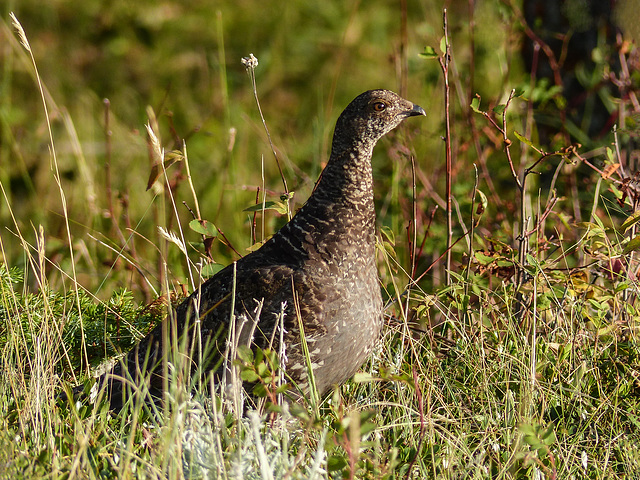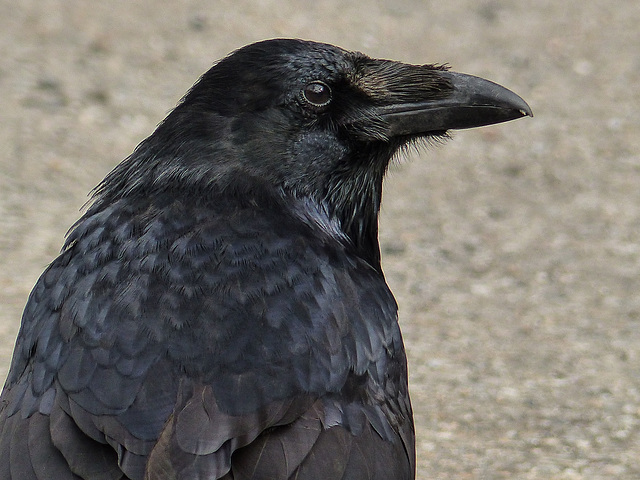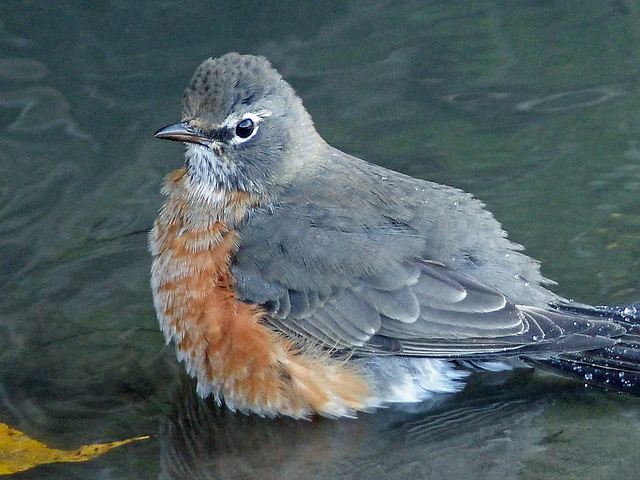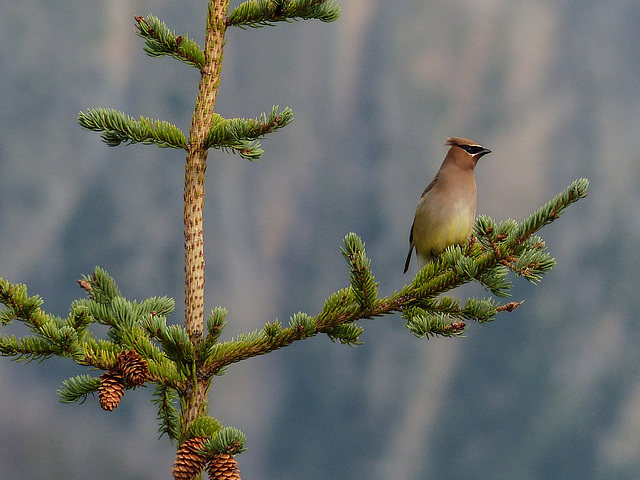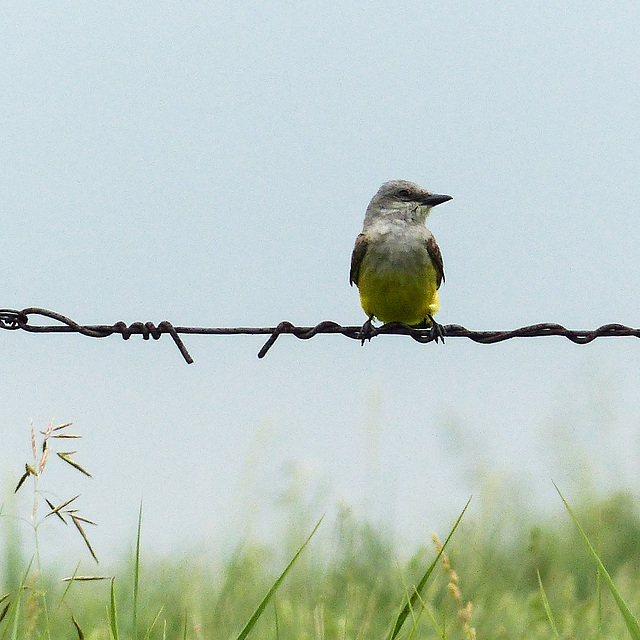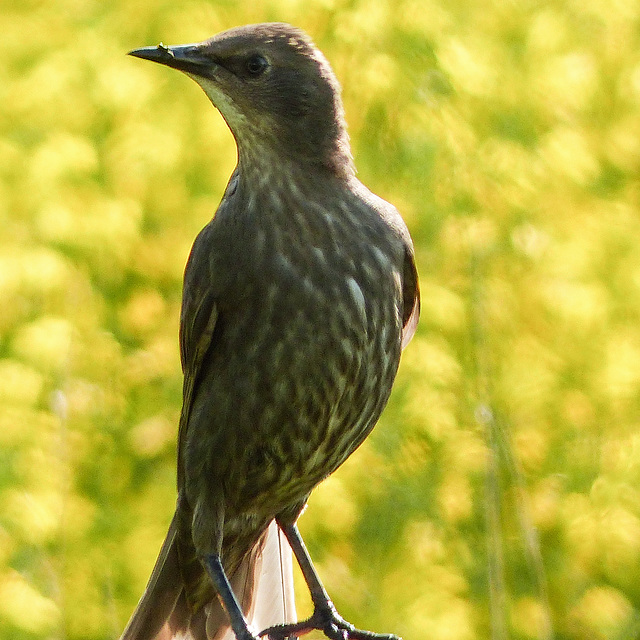
Birds of Alberta 9
06 Sep 2014
Three-toed Woodpecker
When I went back and had a better look through the photos I took at Brown-Lowery Provincial Park on 6 September 2014, I came across this shot that is somewhat sharper and better than most of that day's photos. The weather forecast was for upcoming rain, so I decided that I had better get over to the park straight away, as I wanted to check for any mushrooms. I had been there fairly recently, and only found a couple of things. The visit on 6 September was a little more rewarding and I found several large clusters of tiny mushrooms growing on tree stumps or at the base of trees. Also found several patches of bright orange Coral Fungi. Quite a few people were in the park, so I felt safer going a very short way in. Far enough, as it turned out, to watch an adult and juvenile Three-toed Woodpecker, feeding together on a tree trunk. The young one was copying Mom or Dad, but its soft squeaking sound resulted in the adult feeding it, too. Not sure if this is the adult or the young one in this photo. You can tell this tree has been used by the Three-toed Woodpeckers, as some of the bark has been stripped, leaving the orange/brown wood below. This Woodpecker species seems to be reasonably tolerant of people. These are rare birds here, so I feel very lucky to have seen these two and any others in the past.
birdsofalberta.com/List/detail.php?id=226
www.allaboutbirds.org/guide/American_Three-toed_Woodpecke...
On the way home, I decided to call in at Fish Creek Park, hoping to find a Beaver or a MInk that a friend had told me about. Though I did see a couple of Beavers, I wasn't able to get a decent photo of them that day. One of them was a huge animal - this was the one that was recently found in a trap, biting off one of its front legs that was caught in the trap. Someone had been there when this was happening and she made several reports about it. Thanks, Linda, for doing this. Such a cruel way to deal with any Beaver problem! The now three-legged animal seems to be doing reasonably OK. I was luckier with the Mink, catching it in a couple of very quick shots.
On the walk back to my car, I was lucky enough to see a distant doe and her two fawns. Apparently, there is another doe with triplets in the area.
27 Aug 2014
Dusky Grouse
This photo was taken on 27 August 2014, the second day of a three-day trip down south, to Waterton Lakes National Park with friends, Cathy and Terry. We were driving along the Red Rock Parkway when we noticed a bird crossing the road way in the distance. We weren't sure what kind of Grouse it was, but, when we got closer, I got out of the car and went to see if I could get a better view of it. To my surprise, there were also several young ones hidden in the grasses. Amazingly, they didn't hurry off, out of sight, but instead stayed where they were until my friends came to look. Then another car slowed down and stopped to see what we were looking at, shortly followed by a small van that carried quite a few people. Maybe everyone had perhaps been expecting to see a Bear, ha. After a while, yet another vehicle stopped and out got a Park Ranger. I suspect he thought we were a crowd of foolish people who had got out of their cars to get closer to a Bear. When he realized that all we were watching was a family of Grouse, a big grin appeared on his face. Makes me laugh every time I picture his expression : ) The Checklist of Birds in Waterton Lakes National Park (a pdf file) says that Dusky Grouse are uncommon in the park, so we were lucky.
18 Sep 2014
Watching and waiting
The Common Ravens that are seen within the city are usually flying high overhead or perched right at the top of very tall trees, and I can't get photos of them. Once one is out in the mountains, these very intelligent birds have learned that where there are people, there is often food. Parking lots and pull-offs have become one of their favourite places to hang out, making it possible to get shots of them.
A couple of these large birds were down on the ground at the Elbow Falls parking area yesterday afternoon. This was the first time I had managed to get out there this year and, really on the spur of the moment, that's where I decided to go yesterday. The weather called for some sun and some cloud, which sounded good. After the two heavy snowfalls on 9 and 10 September, I wasn't sure what to expect before I reached the beginning of the mountains, but every bit of snow had disappeared. The furthest point of my drive was Forgetmenot Pond, one of my favourite places to go. This drive is the only one I will do on my own and it only takes about an hour to get from home to the Pond.
On the return drive, I called in at a place not far from the pond, where I have found a few mushrooms in previous years, and managed to find just a few that were in good enough condition to photograph. Other than that, I didn't see a whole lot during the few hours I was out. The scenery is spectacular and there were patches of trees that have turned yellow. Some of the trees looked as though their leaves were past their fall prime, and I came away wondering if I was a bit too early or a bit too late to see the best of the fall colours. The final place I called in at was Maclean Pond, but the light was fading somewhat and so I didn't feel like going far into the forest. I had just got back into my car when I happened to look up just in time to see a family of beautiful Bluejays not far from the parking lot. Managed to get a few shots, but distant and not as sharp as they should have been. A nice way to end the day, though.
14 Sep 2014
1 favorite
Splish, splash, I was taking a bath
This was one of several American Robins that were flying from tree to tree around a small pond and sometimes taking a bath at the edge of the pond. They kept me entertained while I watched and waited, hoping to see at least one Beaver. Taken on 14 September 2014, in Fish Creek Park.
"The American robin (Turdus migratorius) is a migratory songbird of the thrush family. It is named after the European robin because of its reddish-orange breast, though the two species are not closely related, with the European robin belonging to the Old World flycatcher family. The American robin is widely distributed throughout North America, wintering from southern Canada to central Mexico and along the Pacific Coast. It is the state bird of Connecticut, Michigan, and Wisconsin. According to some sources, the American robin ranks behind only the red-winged blackbird (and just ahead of the introduced European starling and the not-always-naturally occurring house finch) as the most abundant, extant land bird in North America." From Wikipedia.
en.wikipedia.org/wiki/American_robin
www.allaboutbirds.org/guide/american_robin/id
20 Jul 2014
2 comments
Burrowing Owl
This is not one of the wild Burrowing Owls that friends, Cathy and Terry, and I, saw in southern Alberta on 28 August 2014. It was part of an exhibit from the Coaldale Birds of Prey Centre that was being held in a park to the west of Calgary, on 20 July 2014. Though I was able to get a much closer shot, the light was not good, and I gave up trying to get the colouring right last night. Only once did this little owl turn its head to look forward, the rest of the time it was turning its head from side to side, non-stop. They really are the cutest little things : )
""As a result of its ENDANGERED Species status in 1995, it has the focus of a variety of conservation efforts. Operation Burrowing Owl and other projects involving habitat preservation with landowners have been created. Populations are monitored by Fish and Wildlife departments. They have been reintroduced into the British Columbia interior, where it was extirpated. Outlook would improve if larger areas of habitat were preserved and harmful pesticides were banned in all areas of their range. Numbers could increase if an increased tolerance to burrowing mammals develops (i.e. badgers) – provides homes for the Burrowing Owl. Outlook: perilous." From burrowingowl.com.
burrowingowl.com/visit/index.php
en.wikipedia.org/wiki/Burrowing_Owl
On 20 July 2014, I plucked up courage to do a drive that I’d never done before. I had been that route once before that I can think of, when I carpooled with others. A good part of the drive was in familiar territory, but I’d never driven the last part of the journey myself. I had met my youngest daughter at 9:00 a.m. and we were both eager to see this display of birds of prey that had been brought up from the Coaldale Birds of Prey Centre.
This year, there were not quite as many birds, but it was great to see any at all. There was this Burrowing Owl, a Barn Owl, a Great Horned Owl, and a Golden Eagle. Another real treat that was an amusing one, was seeing a baby Barn Owl that was just 45 days old! This little ball of fluff was acting as a great ambassador, letting young kids get a close view and ask questions, and fall in love with it – and to hopefully, in the future, do everything they can as adults to protect our precious wildlife. The enjoyment of seeing these birds up close reminds one that the reason these birds are not free to live in the wild, is because of some kind of interaction with humans – such as permanent injuries from being hit by a vehicle, pesticide use, or even worse, being shot by a human! This is what happened to “Spirit”, the magnificent Golden Eagle, shot and blinded by someone.
This exhibit was our first destination in the park, though on the drive from Calgary, we had stopped at the small McDougall Church at Morley. After seeing and photographing the birds of prey, we then drove to Middle Lake that’s in a different part of the park. We walked the very short distance to the edge of the lake, but didn't walk around it. From there, we drove to Many Springs Trail and did a slow walk around the lake, stopping to look at and photograph a few different wildflowers and butterflies. Though slow, it was still further than I should have walked, ha. Certain wildflowers were already finished, including the various Orchid species, but there were still plenty of other species to see and enjoy. Even the weather cooperated, though the forecast had been for isolated showers. Not too hot, nice clouds in the sky and lovely to have my daughter’s company for the day.
19 Aug 2014
Cedar Waxwing with mountain bokeh
Just over a month ago, on 19 August 2014, I was lucky enough to go with friends, Cathy and Terry, for a great day out in the mountains. Our trip was part way along Highway 40 and then along the Smith-Dorrien/Spray Lakes Trail. The weather forecast was not good for this day, but we were so lucky that, apart from a few raindrops, the rain stayed away. The sun actually came out at two locations we stopped at for a short while, including at this one (Mt. Shark), where I photographed this little masked bandit, Cedar Waxwing. The background blur is a distant mountainside.
26 Aug 2014
Mountain Bluebird juvenile
This young Mountain Bluebird was seen when friends, Cathy and Terry, and I, went on a three-day trip (26, 27 and 28 August 2014) down to Waterton Lakes National Park. I can't remember where we saw this little Bluebird - I was thinking it was near the Yellow-bellied Marmots, but that was two days later.
In Bluebirds, the blue colour is produced by the structure of the feather - there is no blue pigment. "Tiny air pockets in the barbs of feathers can scatter incoming light, resulting in a specific, non-iridescent color. Blue colors in feathers are almost always produced in this manner. Examples include the blue feathers of Bluebirds, Indigo Buntings, Blue Jay's and Steller's Jays."
www.allaboutbirds.org/guide/Mountain_Bluebird/id
www.jstor.org/discover/pgs/index?id=10.2307/4077277&i...
10 Jul 2014
1 favorite
Western Kingbird
I remember seeing a very distant Western Kingbird quite a few years ago, but wasn’t able to get a shot of it. Today’s photo is still not a close shot, and not good quality, but I was happy to see and photograph this bird. Thanks, Greg, for your effort to find a new bird or two for me : ) Greatly appreciated – and I’m so glad you were successful in finding a Gray Partridge (seen many times before by you) for your extensive records.
Two days ago, on 10 July 2014, I checked the weather forecast before dashing down to the Frank Lake area, SE of the city. Pretty much a spur of the moment thing. The temperature had gone down a few degrees from the unbearably hot day before, and the sun was shining. On the Weather Network, I discovered that there was a weather Alert in effect, possibly huge hailstones and also the possibility of a tornado. Thinking I might get a chance to see some interesting clouds, I decided that I would still go.
My destination was Frank Lake and the surrounding area, where I bumped into friend, Greg Wagner, who is extremely knowledgeable about the area and its wildlife, and does an amazing job of recording all his sightings. I saw Eared Grebes with their young ones (quite big now), a few White-faced Ibis and Black-crowned Night Herons (no photos). Did manage to get a few shots of a Sora (thanks for telling me to watch out for them, Greg!).
After I'd finished at the blind, Greg took me to various spots around the lake, pointing out places where he had seen interesting things, hoping that they might still be there for me to see. Thanks so much, Greg - I enjoyed this and really appreciated it! One of these was this Western Kingbird - our more common Kingbird is the Eastern, so I was very happy to see a Western. We also passed by a male Great Horned Owl (posted yesterday), who was perched on one of the huge pylons. He and his family seem to be doing well. Photo was quickly taken from inside the car, using 48x zoom and then cropped. Of course, more natural surroundings would have been nicer, but this family of owls likes to use this pylon : )
The clouds were building up as the hours went by (see next photo) and it did rain just a little when I was driving home. Fortunately, no hail or tornado!
"An eye-catching bird with ashy gray and lemon-yellow plumage, the Western Kingbird is a familiar summertime sight in open habitats across western North America. This large flycatcher sallies out to capture flying insects from conspicuous perches on trees or utility lines, flashing a black tail with white edges. Western Kingbirds are aggressive and will scold and chase intruders (including Red-tailed Hawks and American Kestrels) with a snapping bill and flared crimson feathers they normally keep hidden under their gray crowns." From AllAboutBirds.
www.allaboutbirds.org/guide/Western_Kingbird/id
en.wikipedia.org/wiki/Western_kingbird
12 Jul 2014
1 favorite
European Starling juvenile
This (blurry!) bird was seen on 12 July 2014, when I spent a few hours driving the backroads SE of Calgary, in the Frank Lake area. It's so unusual for me to see and photograph a bird that I don't recognize, meaning that I don't see a lot of less usual birds, but I saw two that day (the other turned out to be a Vesper Sparrow). If anyone can tell me the ID of the bird in my photo, that would be greatly appreciated! The background was a colourful field of Canola : )
Thanks to Jack Hayden who identified this as a juvenile European Starling. I don't think I've ever seen a juvenile before, lol!
My first stop was at Frank Lake, where I saw a few more Eared Grebes with their quite large "babies". The light was really bad, so it was impossible to get photos that showed colour and details. Saw Soras again - love these little guys, they are so cute. A few very distant White-faced Ibis, but I lucked out later, finding a lone Ibis at a slough somewhere around the lake.
www.allaboutbirds.org/guide/european_starling/id
en.wikipedia.org/wiki/Common_starling
Jump to top
RSS feed- Latest items - Subscribe to the latest items added to this album
- ipernity © 2007-2024
- Help & Contact
|
Club news
|
About ipernity
|
History |
ipernity Club & Prices |
Guide of good conduct
Donate | Group guidelines | Privacy policy | Terms of use | Statutes | In memoria -
Facebook
Twitter

